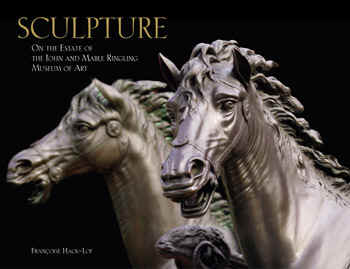 |
Classic casts After restoring 1920s Italian bronzes, Ringling Museum puts their story into
print |
The Ringling Museum, after recently restoring, conserving and cleaning the casts, has
published "Sculpture on the Estate of the John and Mable Ringling Museum of
Art." Written by assistant curator Francoise Hack-Lof, the 14-page
booklet is in a 10 1/2-inch tall by 14-inch format on heavy porcelain paper. It offers
information on the casts and contains fine color illustrations by Sarasota photographer
Giovanni Lunardi, a native of Parma, Italy. Ten photographs are full-page.
The Chiurazzi Foundry, begun by Gennaro Chiurazzi (pronounced "Kiu-RAT-si")
operated in Naples next door to the National Museum of Archaeology, home of many classical
sculptures unearthed at Pompeii and Herculaneum in the 18th century.
Hack-Lof relates how the bronze casts are made of an alloy of 90 percent copper, 10
percent tin plus small amounts of lead and zinc in the ancient lost-wax process. A plaster
mold, often consisting of many parts in a complicated sculpture, is made from the
original.
A core of clay and plaster that will fill the hollow inside of the cast is covered with
wax; the core will be cut out, or dropped, through the bottom after casting. Molten bronze
is poured into a tightly fitted and trussed plaster mold. The hot bronze melts the
"lost" wax and liquid metal fills the mold's inner surfaces.
After the bronze cools, the mold is opened to reveal a three-dimensional copy of the
original. The cast's surfaces may need chasing or other refining. It is important to
capture the cast's surfaces as well as using separate mold pieces to reproduce protruding
human and animal limbs as well as sculptural undercuts.
The foundry, because of its quality of workmanship over more than a century, gained
exclusive access to many museums' ancient sculptures and other three-dimensional works.
Museums today virtually forbid making new casts from their holdings.
The Chiurazzi foundry stopped at the outbreak of World War II in 1939. But a search of the
Internet shows a Chiurazzi grandson, also named Gennaro, has re-established the foundry.
Today the foundry has access to 1,300 plaster casts (according to information at
www.Chiurazzi.com/index2ing.html).
The foundry's sculptures can be seen at important museums in Rome as well as in museums
around the world. Andrew Carnegie and other benefactors gave them to such places as the
Carnegie Museum of Art, Pittsburgh, and the Ashmolean Museum at Oxford University.
The foundry still completes sculptures in the same finishes as in Ringling's day and
earlier. Ringling chose the dark gray finish called "Herculaneum." Others are
"Pompeii" for verdigris (green) finish and "Moderne' for brown.
The Ringling's largest work commands a high site on the courtyard's west wall above a
cascade. It is a copy of Michelangelo's 18-foot "David," carved in marble in
1501-04. The 1911 Chiurazzi catalog lists its "David" as standing 525
centimeters (21 feet) and also 63 centimeters. A 1929 version was as small as 36
centimeters, Hack-Lof writes.
According to the catalog, an order for a sculpture in stock could take up to 15 days to
deliver, whereas an order for a new one would take 20-90 days. Imagine how many workmen
were needed to meet that time frame. The bronzes were shipped by freighter to Florida and
carried by barge to the museum's site on Sarasota Bay.
In more recent times, museums have been more interested in acquiring original examples of
ancient art rather than reproductions for teaching purposes. Although many American
museums have sold off some or all of their casts over the years, these older works,
possessing the patina of age, have gained renewed respect. The Chiurazzi Foundry's casts
were once kept in the basement of the Naples Archaeology Museum. But in 1974-75, the
Chiurazzi family sold its existing copies in bronze and marble the J. Paul Getty Villa in
Malibu, Calif.
The Getty Villa owns 50,000 objects from ancient times. Styled after a grand Roman estate
in ancient Herculaneum, which was buried in hard volcanic effluvia, the museum is a
splendid structure built around a classical arcade on a bluff above the Pacific. After
undergoing extensive redevelopment in recent years, the villa will reopen next winter.
The Ringling Museum of Art is also growing, with construction of a new 30,000 square foot
gallery, an art reference library and a visitor center. It displays its bronze sculptures
around its three-sided arcade and in front of its entrance.
A cast of the famed "Apollo Belvedere" welcomes visitors, along with sculptures
of Venus, Mercury and others. There are bronze casts of two marble centaurs, believed to
be Greek in origin, that Cardinal Giuseppe Furietti excavated in 1736 at the ruins of
Hadrian's Villa near Rome.
Other works include the "Discobolus" (or discus thrower), the "Dying
Gaul" and "Hermes Tying His Sandal." Among the most complicated casts is
"Laocoon," depicting a Trojan priest and his two sons being attacked by a
serpent. The widely admired original was found in Roman earth in 1506 and displayed at the
Vatican.
Perhaps the strangest cast is of "Lygia and the Bull," based on the 1896 novel
"Quo Vadis," in which Emperor Nero condemned a Lygian princess to die in the
arena for her Christian faith. The hapless nude girl, tied on the bull's neck and back,
wears an expression of abject horror. Ringling, always the showman, bought the full-scale
piece.
Donald Miller, of Naples, is a longtime art critic and author of books on artists and
architects.
https://www.naplesnews.com/npdn/ne_columnists/article/0,2071,NPDN_14929_3703926,00.html
More Information like the above.